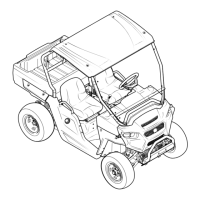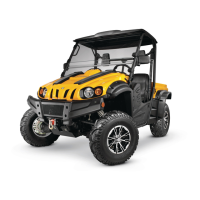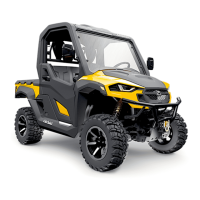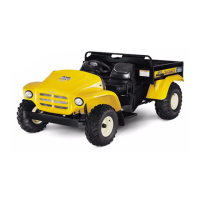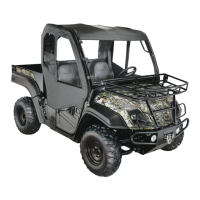10 Section 3— controlS & operation
Loading the Cargo Bed
WARNING
The utility vehicle may become unstable if the cargo bed is
loaded incorrectly. Avoid loose and unsecured loads or uneven
loading of material.
1. Verify cargo bed is securely latched before
loading.
2. Securely anchor all loads in cargo bed and do
not load beyond maximum capacity.
Note: The maximum bed capacity is 350 lb
(158 kg).
3. When loading objects into cargo bed, be sure
load is securely anchored and evenly distributed.
4. Do not load above height of cargo bed. Load
could shift forward striking driver or passenger
or cause driver to lose control of vehicle.
5. Avoid loads which exceed physical dimensions
of cargo bed.
6. Avoid concentrated loads at rear or sides of
cargo bed. Be sure load is distributed evenly.
7. Reduce load and ground speed when
operating over rough or hilly terrain. DO NOT
overload vehicle. Limit loads to those that can
be safely controlled.
Raising & Lowering the Tailgate
1. Unlatch the tailgate from cargo bed and
lower. See Figure 3-7 and Figure 3-8.
Figure 3-7
Figure 3-8
2. Raise and re-latch the tailgate to the cargo bed.
See Figure 3-8 and Figure 3-9. Do not drive the
vehicle with tailgate in the lowered position.
Figure 3-9
Raising & Lowering Cargo Bed (Dumping Loads)
WARNING
To prevent the possibility of bodily injury from unintentional
lowering of the cargo bed, be sure vehicle is on a level and stable
surface and parking brake is set before raising cargo bed.
WARNING
A loaded cargo bed can be very heavy. Do not attempt to
dump a heavily loaded cargo bed.
1. Park the vehicle safely on level ground and set
parking brake.
2. Empty heavy cargo by hand.
3. For light loads, unlatch cargo bed by pushing
forward on the cargo bed latch lever. While
holding the latch lever forward with one
hand, lift the cargo bed with your other hand.
See Figure 3-10.
Cargo Bed
Latch Lever
Lift Up Cargo Bed
From Here
Figure 3-10
4. Once unloaded, lower bed and securely
latch before operating unit. Do not drive the
vehicle with cargo bed in the raised position.
Towing Loads
WARNING
To help prevent personal injury due to loss of control or
tipping, always tow a load slow enough to maintain control.
1. Do not tow a load that exceeds 500 lb (226
kg) rolling weight (i.e. trailer plus cargo) and
never exceed 85 lb (38 kg) tongue weight.
2. Go slow when towing a heavy load. Allow
for increased braking distance. Tow load at a
speed slow enough to maintain control.
3. Do not tow on slopes greater than 5°.
4. Be cautious when towing downhill, even
on a gradual slope or when turning. The
extra weight tends to push the tow vehicle
and may cause you to lose control (braking
and steering ability are reduced; towed
equipment may jack-knife).
IMPORTANT: Extreme angles such as high
railroad crossings can place high bending
loads on hitch connection.
5. Do not modify the hitch in any way.
How to load a Utility Vehicle into a Truck or onto a Trailer
WARNING
Always park the truck or trailer in a flat area, set the parking
brake, turn the ignition off and chock the wheels to prevent
any unexpected movement while loading the utility vehicle.
WARNING
Fully secure the loading ramps to the truck or trailer with
tie-down straps or cables to prevent the ramps from sliding
off while loading. Keep bystanders and/or helpers away from
ramps while loading.
Due to the overall size and dimensions, loading a
utility vehicle into a truck or onto a trailer is a task that
requires precision and the proper equipment to be
achieved safely. By following the steps outlined below
you’ll be able to select the proper equipment to do
the job and safely load and unload your utility vehicle.
Determine if your truck or trailer is sufficient
for the task
Loading a utility vehicle into a truck or trailer that
can’t support its weight is extremely dangerous. It is
important that before any actual loading is done, make
sure your truck or trailer and loading ramps are sufficient
for loading and hauling the utility vehicle. Here are some
of the variables you need to take into account:
• Length and width: Measure the size of your
truck or trailer by taking width and length
measurements at the floor level. Compare these
measurements to the width and length of your
utility vehicle to make sure it will fit comfortably.
• Weight Capacity: Making sure your truck or
trailer can handle the payload of your utility
vehicle is another critical task before any
loading is done. If using a truck, the payload
capacity must be a minimum of ¾ ton. If
hauling on a trailer, remember that the towing
capacity of the vehicle will be reduced by the
added weight of the utility vehicle.
• Tailgate Considerations: If the payload
capacity is sufficient for hauling in a truck, the
last thing left to consider is your truck’s bed
length. Make certain that your truck bed is
long enough to allow the truck’s tailgate to
close completely when the utility vehicle is
loaded into the truck bed.
Choosing the proper loading ramp(s)
Choosing a reliable ramp and understanding how to
properly use it is far and above the best option for safely
loading a utility vehicle into your truck or onto your
trailer. Take a look at the considerations you should have
in mind when choosing the proper ramp(s):
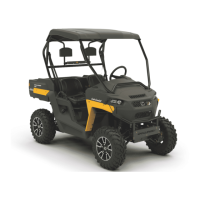
